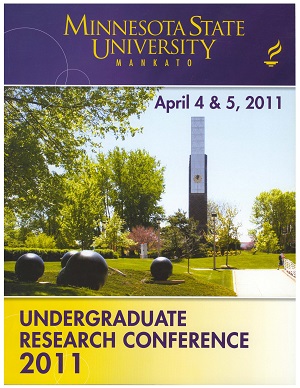Event Title
Cellulosic Ethanol from Cattail Leaves
Location
CSU 253/4/5
Start Date
4-4-2011 11:00 AM
End Date
4-4-2011 12:30 PM
Student's Major
Chemistry and Geology
Student's College
Science, Engineering and Technology
Mentor's Name
James Rife
Mentor's Department
Chemistry and Geology
Mentor's College
Science, Engineering and Technology
Description
Fuel-grade ethanol can be made from any appropriate source of carbohydrate. Cellulose, an abundant polysaccharide found in plant cell walls, can be converted into the readily fermentable sugar glucose. Previous work in this lab demonstrated that cattails are viable source for the production of cellulosic ethanol allowing the use of cattail leaves rather then food crops to make ethanol. The current project carried cattail biomass through the steps necessary to convert cellulose into ethanol. To improve workability, the leaves were dried and ground to a powder. The resulting powder was pretreated to break open the cell wall lattice and make the cellulose accessible to hydrolytic enzymes. We evaluated pretreatments of cattails using phosphoric acid, sulfuric acid, and water. Pretreated samples were then treated with cellulase and b- glucosidase to hydrolyze the cellulose to glucose. The amounts of these enzymes were varied to optimize the conversion to glucose. The final step involved using Saccharomyces cerevisiae to the ferment the liberated glucose into ethanol. Fermentation of the glucose obtained from all three pretreatment conditions was compared to see if pretreatment impacted ethanol production. High Performance Liquid Chromatography was used at the different stages to measure glucose and ethanol levels. Final levels of glucose and ethanol were compared against the initial amount of cellulose to compare the efficiencies of the three pretreatment methods.
Cellulosic Ethanol from Cattail Leaves
CSU 253/4/5
Fuel-grade ethanol can be made from any appropriate source of carbohydrate. Cellulose, an abundant polysaccharide found in plant cell walls, can be converted into the readily fermentable sugar glucose. Previous work in this lab demonstrated that cattails are viable source for the production of cellulosic ethanol allowing the use of cattail leaves rather then food crops to make ethanol. The current project carried cattail biomass through the steps necessary to convert cellulose into ethanol. To improve workability, the leaves were dried and ground to a powder. The resulting powder was pretreated to break open the cell wall lattice and make the cellulose accessible to hydrolytic enzymes. We evaluated pretreatments of cattails using phosphoric acid, sulfuric acid, and water. Pretreated samples were then treated with cellulase and b- glucosidase to hydrolyze the cellulose to glucose. The amounts of these enzymes were varied to optimize the conversion to glucose. The final step involved using Saccharomyces cerevisiae to the ferment the liberated glucose into ethanol. Fermentation of the glucose obtained from all three pretreatment conditions was compared to see if pretreatment impacted ethanol production. High Performance Liquid Chromatography was used at the different stages to measure glucose and ethanol levels. Final levels of glucose and ethanol were compared against the initial amount of cellulose to compare the efficiencies of the three pretreatment methods.
Recommended Citation
Sanchez, Daniel. "Cellulosic Ethanol from Cattail Leaves." Undergraduate Research Symposium, Mankato, MN, April 4, 2011.
https://cornerstone.lib.mnsu.edu/urs/2011/poster-session-B/22



